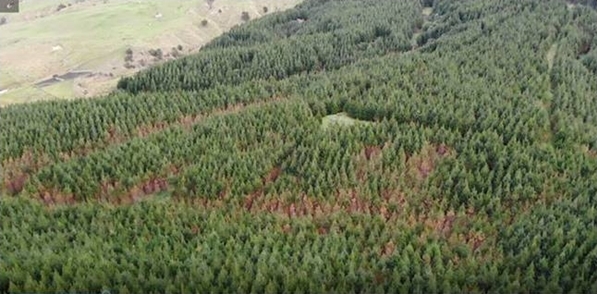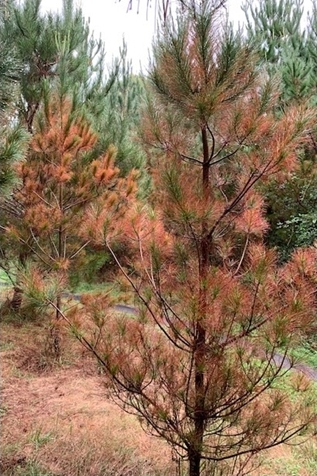PESTS AND DISEASES OF FORESTRY IN NEW ZEALAND
The achievements of Dothistroma management in New Zealand
Scion is the leading provider of forest-related knowledge in New Zealand
Formerly known as the Forest Research Institute, Scion has been a leader in research relating to forest health for over 50 years. The Rotorua-based Crown Research Institute continues to provide science that will protect all forests from damage caused by insect pests, pathogens and weeds. The information presented below arises from these research activities.
From Forest Health News No. 312 - December 2022
Dothistroma needle blight (Dothistroma septosporum) was first noted in NZ in 1962 and spread to susceptible areas rapidly. It was widespread in the North Island and upper South Island by the end of the decade. Severe effects in the South Island are generally only found in wetter areas such as the West Coast.
As a fungal disease, Dothistroma thrives in moist warm areas and where conditions are suitable, quickly causes death of needles that then fall off the tree. Infection levels above about 25% of the green crown can result in significant loss of growth. Trees that have been repeatedly infected are often very easy to distinguish due to small diameter, small and often dead lower branches, and poor foliage retention. These trees are often in gullies (as seen in the photo below) and on ridge tops where moisture persists.

Dothistroma in gullies where moisture persists. Photo: Hawkes Bay Regional Council.
Given the rapid rise in infection levels and impact on growth, FRI as it was then, turned its attention to how adverse effects might be reduced.
Copper is a well-known fungicide and used extensively in various forms worldwide. Spraying of forests however is more problematic and not widely practiced either in NZ or elsewhere in the world. Scientists from FRI (firstly John Gilmour and then John Ray) quickly tested and developed methods for applying copper fungicides aerially to large areas of forest.
The Dothistroma Control Committee was established in 1966 to coordinate the control of this disease. The Committee was formed by the NZ Forest Service with support from large private forest owners. At that time, the NZFS managed over half the planted forest estate and had the staff and resources to support the effort.
The role of the Committee initially included supporting the research programme, assessing the extent of infection each year through aerial surveys, purchasing sufficient copper for the programme and coordinating the application of the spray.
In the early days, application was by fixed wing aircraft (helicopters in NZ were still small, rare and were not widely used for agricultural and forestry work).

Dothistroma infected trees showing low levels of needle retention and small diameter stems and branches. Photo: D Hammond.
Early research demonstrated an application of 4.16kg of copper oxychloride in 50 litres of water in late spring provided control of the disease.
The scientists along with support from NZFS managers and private forest managers sought to continually improve the management of the disease and in the early 1980s recommended a profound change to the application methodology. Technology changed from traditional large droplet nozzles to micronairs, achieving the tiny drops required to get coverage from low volume spraying.
The addition of oil to the mix, and using drift spraying with fine droplets gave excellent coverage of needles and hence control of disease. The real benefit came from significantly lower application rate – 5 litres per hectare with only 1.66kg copper oxychloride and 2 litres of oil. Substantial cost savings were achieved, better control and greater ability to optimise suitable spray days as an aircraft could now treat 100 hectares with a load instead of 10 hectares each load.
Environmentally there were also advantages in these changes, although, these were not major drivers for the change at that time.
Helicopters were also becoming more common in forestry and agriculture and were used increasingly in hilly areas or small forest blocks. Today, helicopters have largely taken over completely from fixed wing aircraft for Dothistroma control spraying.
In the late 1990s, new technology for producing copper fungicides became available. This coincided with the start of the economic transformations in China. Copper fungicides were often produced from recycled copper, which often had impurities from solder, such as lead. As China grew, they began buying all the ‘scrap’ copper in the world forcing fungicide manufacturers to turn to newly mined copper sources.
These manufacturers also developed cost effective technology for manufacturing cuprous oxide, which became a more cost competitive alternative to oxychloride. In turn, due to the greater amount of copper in oxide (75%) compared to oxychloride (50% copper), further reductions in application rates become possible with the same or potentially improved control due to the lower solubility of oxide compared to other copper compounds.
Today, forest owners apply 1.14kg of cuprous oxide with 2 litres of oil made up to 5 litres with water. Some owners are even using 3 litres of spray mix being the copper and oil only. The scientists have not only focused on treatment technology but most radiata tree stocks have an increased level of Dothistroma resistance bred into them than previous generations of trees.
The Dothistroma Control Committee, now in its 56th year, continues to support innovative research, focusing on application technology, alternatives to copper and environmental impact studies. The committee also continues to support forest owners, sourcing copper and oil at competitive rates and coordinating spray programmes to get the most effective outcomes for forest owners, large and small.
The Committee is an outstanding example of all forest owners working together to achieve a common goal of healthy productive forests, supported by excellent ongoing research.
Don Hammond and Lindsay Bulman
This information is intended for general interest only. It is not intended to be a substitute for specific specialist advice on any matter and should not be relied on for that purpose. Scion will not be liable for any direct, indirect, incidental, special, consequential or exemplary damages, loss of profits, or any other intangible losses that result from using the information provided on this site.
(Scion is the trading name of the New Zealand Forest Research Institute Limited.)

 Farm Forestry New Zealand
Farm Forestry New Zealand

